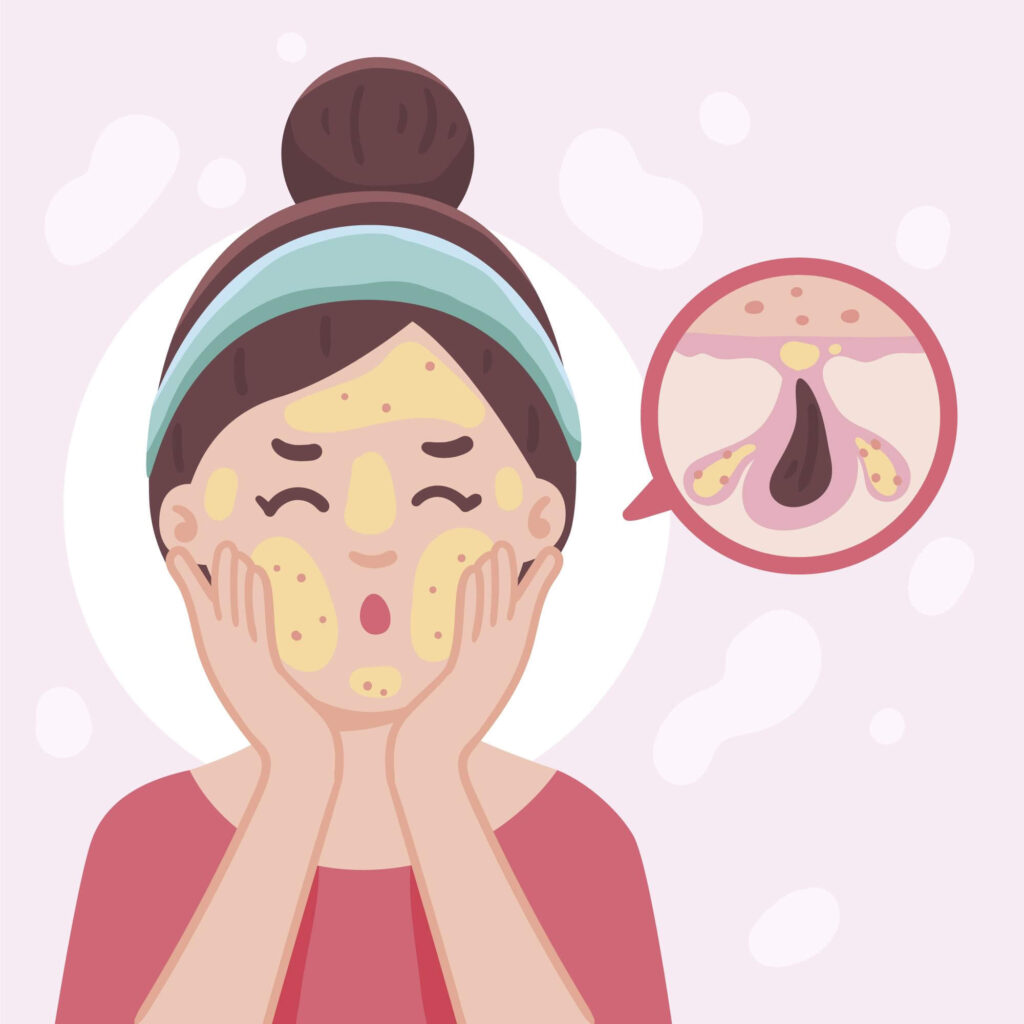Acne and Open Pores

Acne:
Acne is a skin condition – clogged pores and blemishes. They are often resulted from excess oil production and hormonal changes. They can effectively be treated with topical medications, laser therapy, and customized plans to address its causes and symptoms.
Causes of Acne:
- Excess Sebum Production: Overproduction of skin oil (sebum) can clog hair follicles, leading to acne.
- Clogged Pores: When hair follicles become clogged with oil and dead skin cells, it provides an ideal environment for acne-causing bacteria to thrive.
- Hormonal Changes: Fluctuations in hormones, often seen during puberty, pregnancy, and menstruation, can increase the likelihood of acne.
- Diet: Certain dietary factors may contribute to acne in some individuals.
Common Symptoms of Acne:
- Blackheads and Whiteheads: Non-inflammatory acne appears as blackheads and whiteheads, often on the face, chest, and back.
- Papules and Pustules: Inflammatory acne presents as red, tender bumps (papules) and pus-filled lesions (pustules).
- Cysts and Nodules: Severe acne can lead to painful, deep cysts and nodules that may cause scarring.
Treatments for Acne:
- Topical Medications: Prescription or over-the-counter creams and gels may be recommended to reduce inflammation and unclog pores.
- Oral Medications: In some cases, oral antibiotics or contraceptives may be prescribed to manage hormonal acne.
- Chemical Peels: Chemical peels exfoliate the skin, helping to remove dead cells and reduce acne blemishes.
- Laser Therapy: Advanced laser treatments can target and destroy acne-causing bacteria and reduce inflammation.
- Microdermabrasion: Microdermabrasion exfoliates the skin, improving its texture and reducing acne scars.
- Customized Treatment Plans: Our professionals create personalized plans tailored to your unique skin and acne type.
- Post-Treatment Care: We provide guidance on post-treatment care to maintain results and prevent acne recurrence.
Open Pores:
Open pores are bigger skin holes that can be, often because of too much oil, getting older, or genetic factors.
Causes of Open Pores:
- Excess Oil Production: Overactive sebaceous glands can make pores appear larger.
- Aging: As we age, the skin loses elasticity, causing pores to appear more noticeable.
- Genetics: Some individuals inherit a tendency for larger pores.
Common Symptoms of Open Pores:
- Visible Pores: Open pores are larger and more noticeable, particularly on the nose, cheeks, and forehead.
- Dull Skin: Skin with enlarged pores may look dull or rough.
Treatments for Open Pores:
- Chemical Peels: Chemical peels exfoliate the skin, promoting the growth of new, healthier skin and reducing the appearance of large pores.
- Laser Resurfacing: Laser treatments can tighten the skin and reduce the size of open pores.
- Topical Solutions: We may recommend topical products with retinoids to improve skin texture and reduce pore size.
- Customized Treatment Plans: Our experts tailor treatments to address your specific concerns and skin type.
- Post-Treatment Care: We offer guidance on maintaining results and preventing pore enlargement.
Can anyone get acne?
Yes, acne can affect people of all ages and skin types.
What's the connection between hormones and acne?
Hormones can make oil glands produce more oil, leading to acne.
Are there foods that cause acne?
Some people find that certain foods trigger acne, but it varies from person to person.
Are acne scars permanent?
Acne scars can fade, but they might not completely go away without treatment.
How is acne treatable?
Treatments like laser therapy, chemical peels, and topical solutions customized to skin type are effective to treat acne problems.
What causes open pores on the skin?
Open pores are often due to excess oil production, aging, or genetics.
Can open pores be permanently closed?
While they can't be permanently closed, treatments like chemical peels and laser resurfacing can reduce their appearance.
How long does it take to see results with open pores treatments?
The time to see results varies, but many people notice improvements after a few sessions of treatment.
